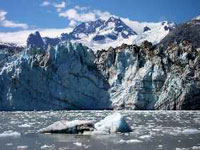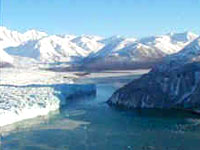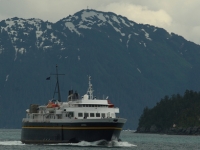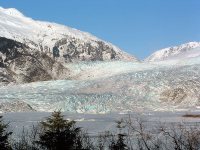City guides


The Inside Passage Travel Guide
Shaped by the carving of massive glaciers millions of years ago, Southeast Alaska is an astounding region of deep fjords, glaciers, majestic mountains and forests. Known as the 'panhandle', it epitomises classic Alaskan scenery. Thousands of islands form a pristine protected waterway called the Inside Passage that is lined with many charming towns and small villages rich in history. About half of the tourists who travel to Alaska arrive on cruise ships that wind their way through the islands of the Inside Passage to ports of call such as Ketchikan, Juneau, Sitka and Skagway.
The area is home to the native cultures of the Tlingit, Haida and Tshimshian tribes; the art of totem pole carving, as well as traditional music and dance have been preserved, especially in Ketchikan. Russian settlers have also left their legacy of icons and onion-domed churches, having been drawn to the region in search of fur. The region's promise of gold, salmon fishing and forests of timber attracted many other profiteers. Today the business of tourism is an additional income-earner for many of the picturesque coastal communities.
The history of the Gold Rush days is especially evident in the town of Skagway at the northern tip of the Inside Passage, once a lawless trading post serving the Klondike Gold Rush pioneers. Juneau is Alaska's attractive capital, and has a bustling waterfront and a scenic mountain backdrop. It's the gateway to one of the country's most glorious regions, Glacier Bay National Park.
Things to do in The Inside Passage
Alaskan cruises explore the rugged scenery of craggy islands, jutting glaciers and forested coastline, weaving through the Inner Passage, up the Gulf of Alaska and past scores of islands and inlets. Cruise ships traverse a string of coastal cities that include Ketchikan, Skagway, Haines, Sitka and Juneau. Stacked together, their unique atmospheres make a diverse totem pole of cruise ports with Juneau at the top.
Most ships will call port in Juneau, a unique state capital nestled into mountain steps and a narrow inlet. The small city is accustomed to water transportation as no roads lead in or out of the city. Cruise liners are berthed at one of three docks, all within an easy walk of a rustic and charming downtown area. Here, visitors can take a tramway up Mount Roberts to share an eagle's view of the city and landscape below. Visitors can also view scenery with whale watching tours starting from Juneau's waterfront. Those in port for longer stays can catch a ferry to Glacier Bay National Park to see 16 enormous glaciers cut into the land and sea. Others can visit Mendenhall Glacier, close to town.
With no roads connecting the towns the best way to travel is by the Alaska Marine Highway ferry that hops from town to town, or on one of the numerous and very popular cruises that ply the channels. The Alaska Marine Highway is a designated National Scenic Byway and is one of the most beautiful ways to explore Alaska. The deep waters and mild climate provide a prime habitat for whales, sea lions and porpoises, which can often be spotted from the deck. Between the picturesque fishing town of Petersburg and Russian-founded Wrangell is the spectacular Wrangell Narrows that is only 300ft (91m) wide and so shallow in places that the boat is forced into a slalom course of 46 turns to avoid grounding on the channel bottom. Frederick Sound is a prime whale sighting area.

Glacier Bay National Park
When the early explorers and pioneers of the 18th century sailed this way, Glacier Bay was hidden under a huge sheet of solid ice, more than 4,000ft (1,219m) thick and up to 20 miles (32km) wide. Today the branching 65-mile (105km) long fjord is the work of the fastest-receding glacier on earth; the melting ice of the Grand Pacific Glacier opening up a spectacular carved terrain of steep rock walls lining deep-water fjords.
Sliding out of the mountains are 16 active glaciers that fill the sea with different shaped icebergs, creating the icy blue landscape that is world-renowned. At the head of the fjord is the massive ice wall of the Grand Pacific Glacier, slowly melting and sculpting the still-unfinished land as it backs away from the sea, a natural work of art in progress.
An added attraction is the variety of aquatic life including humpback whales, sea otters, seals and porpoises, while bears, moose, mountain goats and many species of birds inhabit the land. This rugged landscape can only be accessed by boat or small plane as most of the park is made up of water. As opportunities to see this huge wilderness are limited, facilities can be crowded, especially on the tour boats.
Activities are somewhat expensive, and wildlife sightings cannot be guaranteed. Gustavus is the small settlement that services the park, but the park headquarters is at Bartlett Cove from where boats can be arranged or alternate means provided to enjoy the park experience. Kayaking or camping in the backcountry, ranger-led programmes or walks, hiking and fishing are all available.

Hubbard Glacier
There is surely no more spectacular experience on the planet than to witness the calving of a titanic glacier. A stopover to watch nature's incredible marvel, the Hubbard Glacier, in action as the high wall of ice thickens and advances towards the Gulf of Alaska is one of the unforgettable moments that makes thousands of holidaymakers opt for an Alaskan cruise every year. The Hubbard Glacier is the largest tidewater glacier in North America, beginning its 75-mile (121km) journey to the sea on the tallest mountain in Canada, Mount Logan, and finally shedding tons of its bulk in awesome ice falls across the six-mile (10km) wide head of Yakutat Bay. Every day cruise liners pull in, their passengers bundled up in their warmest clothing and festooned with cameras and binoculars, as they hang over the deck rails to witness the stunning sight of the luminous blue-green ice wall as it creeps inexorably forward. Those who visit at the right time could be fortunate enough to see one of nature's most awesome events, when a chunk of ice cracks and falls thunderously from the wall into the ocean as the mighty glacier calves, startling the seals basking on ice floes.

Alaskan Ferry
Large cruise ships regularly travel to major ports in Alaska but a better idea for those who prefer a more intimate option is the Alaskan Ferry. Departing from Bellingham, Washington, these large ferries bounce through the major coastal towns of Canada and The Gulf of Alaska before stretching to the Alaskan Peninsula. The landscapes are staggering, revealing hundreds of craggy forest-dense islands and coastlines. Eagles, killer whales, bears and other hardy wildlife are all part of the view. The months of operation are May to September, when the weather is bearable and sunshine illuminates most of the evening hours. Costs vary greatly depending on the length of the voyage and style of accommodation. Most ferries rent out cabins but those in tune with Alaska's pioneer spirit can pitch a tent on deck or just use a blanket.

Mendenhall Glacier
The most popular attraction in Juneau is the Mendenhall Glacier, located just 12 miles (19km) from the downtown area. Originally known as Sitaantaagu ('the Glacier Behind the Town') by the Tlingits, it was renamed in honour of Thomas Corwin Mendenhall, a noted American scientist, in 1892. He was responsible for surveying the international boundary between Canada and Alaska. The Mendenhall Glacier is 1.5 miles (3km) wide, and calves into its own lake. Visitors have several options for seeing the Mendenhall Glacier. It can be viewed from the Mendenhall Glacier Visitor Center, which includes a recreation area that's good for viewing black bears; or visitors can hike to the glacier via the Mendenhall Glacier West Glacier Trail, which takes roughly five hours both ways. It's a good idea for visitors to hike with a guide, and bring crampons if they want to hike on the glacier itself. As an added option, several businesses in Juneau offer helicopter rides to the glacier itself, although these are fairly expensive.
United States of America travel info
Electricity
The electrical current is 120 volts, 60Hz. Plugs are mainly the type with two flat pins, though three-pin plugs (two flat parallel pins and a rounded pin) are also widely used. European appliances without dual-voltage capabilities will require an adapter.
Language
English is the most common language spoken but Spanish is often heard in the south-western states.
Money
The official currency is the US Dollar (USD), which is divided into 100 cents. Only major banks exchange foreign currency. ATMs are widespread and credit cards are widely accepted; Apple Pay and Google Pay are very popular. Banking hours are Monday to Friday 9am to 3pm.
Tipping
A 15 percent tip is expected by taxi drivers, bartenders, hairdressers and waiters, but travellers shouldn't tip in fast-food or self-service restaurants. In expensive restaurants or for large parties, the tip should be 20 percent of the bill. It's normal to tip staff such as valets and porters in hotels; this is discretionary, although a minimum of $5 is expected. Most services are customarily tipped if the service is good.
Health
There are no specific health risks associated with travel within the USA. Medical facilities are excellent, but expensive. Only emergencies are treated without prior payment and treatment can be refused without evidence of insurance or proof of funds. Good medical insurance is essential.
Safety
Travel within the United States is generally trouble-free, though travellers should be aware that the US shares with the rest of the world an increased threat from terrorist incidents. Security has been heightened, particularly at airports. Restrictions on hand luggage apply and travellers are advised to check on the latest situation with airlines in advance. Travellers should also be alert to the dangers of car and street crime in cities and should use common sense and take basic precautions. Hurricanes are common between June and November, putting the southern USA, including the Gulf Coast and the eastern US at risk. There's a risk of wildfires in many dry areas in the US, particularly on the West Coast from March to November.
Local customs
Laws vary from state to state, including speed limit, fines and punishment. The age at which alcohol may be legally bought and consumed is 21 years.
Doing business
In such a large country, filled with so many diverse groups, business practices may differ according to each state, though rarely to any large degree. The East Coast is traditionally more formal than the West Coast, though in states such as California, dress code and conservative appearance are as common as they would be in New York. Punctuality is important throughout the country and it's considered rude to be late for a meeting. Gift-giving is uncommon as it may be construed as bribery. Appropriate titles (Mr, Mrs, Ms) are used upon introduction and until otherwise stated. Americans favour politeness and greetings of 'Hello' and 'How are you?' are often expressed with sincerity. Business hours may vary in each state, but an 8am start and 5pm finish Monday to Friday is the most common with an hour over lunch.
Status and age are not necessarily indicative of seniority, nor do they carry much weight in themselves. Those doing business in the States should be mindful of this fact; foreigners should never make assumptions about someone's position or rank. Best practice is to be respectful to all parties. That said, the US upholds a hierarchal business structure in which 'the boss' is the ultimate decision-maker. Senior leaders have the power of the last word, and can go against the grain just as easily as they can follow popular opinion. Foreigners should concentrate on winning over this individual, even if the greater group seems unsupportive. Americans value a direct style of communication. In this fast-paced, consumer culture 'time is money', and small-talk is viewed as unnecessary and wasteful. It's best for foreigners to get to the point quickly, speak about issues in a frank and open manner, and to avoid taking offence if someone questions or challenges them outright.
Duty free
Travellers to the United States who are returning residents of the country do not have to pay duty on articles purchased abroad to the value of $800 provided their stay was longer than 48 hours and their duty-free allowance was not used in the 30-day period prior. For passengers arriving from Samoa, Guam and the U.S. Virgin Islands, a duty-free allowance of $1,600 is allowed. The following items are included in this: 50 cigarettes and 10 cigars and 150 millilitres (5 fl. oz.) of alcoholic beverages or 150 millilitres (5 fl. oz.) of perfume containing alcohol. Restrictions may apply to goods from Cuba, Iran, North Korea, Burma (Myanmar), Angola, Liberia and Sudan. It is prohibited to import Cuban cigars from any country.
Travellers to the United States who are non-residents do not have to pay duty on the following items: 50 cigars or 200 cigarettes and gifts to the value of $100 provided their stay in the USA is not less than 72 hours and that the allowance has not been used in the preceding six-month period.
Prohibited items for residents and non-residents include meat or meat products, poultry, narcotics, absinthe, plants, seeds, vegetables, fruits, soil, live insects and other living plants or animal pests. Fish is prohibited unless it carries disease-free certification. Wildlife and animals or their by-products carry restrictions. Dairy products and eggs from specified countries are not allowed. Firearms and ammunition are not allowed without the necessary license and permit.
Communications
The international country dialling code for the United States is +1. Mobile networks cover most of the country, especially all urban areas; travellers can purchase local prepaid SIM cards for unlocked phones or use eSIMs if their cellular providers support it on their networks. WiFi is widely available.
Passport & Visa
It is highly recommended that travellers' passports have at least six months' validity remaining after the intended date of departure from them travel destination. A visa is required for short visits unless travellers qualify for entry under the Visa Waiver Program.
The Visa Waiver Program (VWP) enables citizens of certain countries to travel to the US for a stay of up to 90 days without a visa. Visitors under the VWP need a valid Electronic System for Travel Authorization (ESTA), which allows the US government to screen all visitors before travel. Visitors entering the country under the VWP must have a machine-readable passport (MRP) that has a barcode on the photo page. Travellers under the VWP must have passports that include biometrics if they wish to enter the country without a visa, which means that passports must contain unique personal data such as fingerprints or iris details. All passports must contain a digital photo image in order to travel visa-free. All visitors to the USA have a photograph and two fingerprints taken by an inkless scanner on arrival, including those travelling visa-free under the VWP.
As part of the Western Hemisphere Travel Initiative (WHTI), all travellers travelling between the United States and Canada, Mexico, Bermuda, and the Caribbean region are required to present a passport or other valid travel document to enter or re-enter the United States. If departing from the USA, a valid passport is required by immigration authorities. Immigration officials often apply different rules to those stated by travel agents and official sources.
Entry requirements
US citizens require passports.
UK nationals require a passport valid for duration of stay. Most passport holders can get an Electronic System for Travel Authorisation (ESTA) through the Visa Waiver Programme, which allows travel to the US for up to 90 days. The VWP includes tourism, certain types of business visit and transit to another country.
The most important requirement on entering the U.S. is providing proof of Canadian citizenship. A valid Canadian passport is the best document to prove Canadian citizenship and the right to return to Canada. However, several other documents can serve, depending on the mode of transport. Generally, Canadian citizens do not require visitor, business, transit or other visas to enter the United States from Canada, though there are some exceptions.
Passports must be valid for the period of intended stay. If visiting the US for fewer than 90 days, Australian nationals may be eligible to apply for an Electronic System for Travel Authorization (ESTA), and enter under the Visa Waiver Program (VWP).
South Africans must hold a passport valid for duration of stay. A visa is required.
Passports must be valid for duration of stay. Irish nationals can get an Electronic System for Travel Authorisation (ESTA) under the Visa Waiver Programme for entry into the United States.
Passports must be valid for duration of stay. New Zealand nationals can get an Electronic System for Travel Authorisation (ESTA) under the Visa Waiver Programme for entry into the United States.
Useful contacts
United States Tourist Office: www.usatourist.com
911 (General)Embassies / consulates in other countries
United States Embassy, London, United Kingdom: +44 20 7499 9000.
United States Embassy, Ottawa, Canada: +1 613 688 5335.
United States Embassy, Canberra, Australia: +61 2 6214 5600.
United States Embassy, Pretoria, South Africa: +27 12 431 4000.
United States Embassy, Dublin, Ireland: +353 1 668 8777.
United States Embassy, Wellington, New Zealand: +64 4 462 6000.
Embassies / consulates in United States of America
British Embassy, Washington DC: +1 202 588 6500.
Canadian Embassy, Washington DC: +1 202 682 1740.
Australian Embassy, Washington DC: +1 202 797 3000.
South African Embassy, Washington DC: +1 202 232 4400.
Irish Embassy, Washington DC: +1 202 462 3939.
New Zealand Embassy, Washington DC: +1 202 328 4800.


